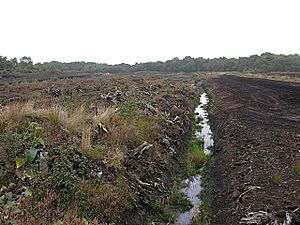Lindow Moss facts for kids
Lindow Moss, also known as Saltersley Common, is a special kind of peat bog near Wilmslow in Cheshire, England. It's like a big, squishy wetland. People have used this land for a very long time, even since the Middle Ages. It became famous in 1984 when a very old, preserved body, called Lindow Man, was found there.
The Story of Lindow Moss
Lindow Moss formed after the last ice age. When huge ice sheets melted, they left behind hollows in the ground. Over thousands of years, these hollows filled with water and dead plants, slowly creating the peat bog.
Some people believe this bog was a very important religious place for the ancient Celts. The first time Lindow Moss was written about was in 1421. At that time, the local lord allowed people to dig peat from the mossland. They used this peat as fuel to keep warm.
Originally, Lindow Moss was huge, covering more than 600 hectares (about 1,500 acres). Today, it is much smaller, only about a tenth of its original size. Bogs can be tricky places; in the 1700s, some writers even reported that people had drowned there.
Peat: A Useful Resource
For hundreds of years, people have dug peat from Lindow Moss. Peat is made from plants that have partly decayed in the wet, boggy conditions. It burns well, so it was a common fuel for homes.
Today, peat is still taken from the bog, but for a different reason. It is now mixed into compost, which helps plants grow better in gardens. Large machines are used to dig the peat, making the process much faster.
Wildlife at Lindow Moss
Lindow Moss is home to many interesting plants and animals. You can find plants like hare's-tail cottongrass and common cottongrass. These plants have fluffy white tops that look like cotton.
The bog is also a habitat for different animals. You might spot the bright green green hairstreak butterfly flying around. It has also been a home for water voles, which are small, furry creatures that live near water. However, the water levels in the bog are dropping, which threatens the water voles' survival.
Protecting Lindow Moss
Many people want to keep Lindow Moss safe and healthy. The Saltersley Common Preservation Society works hard to protect this special place. In 2011, they worked with a local filmmaker. Together, they made a short video. This video shared the history of the bog and talked about the challenges it faces.


